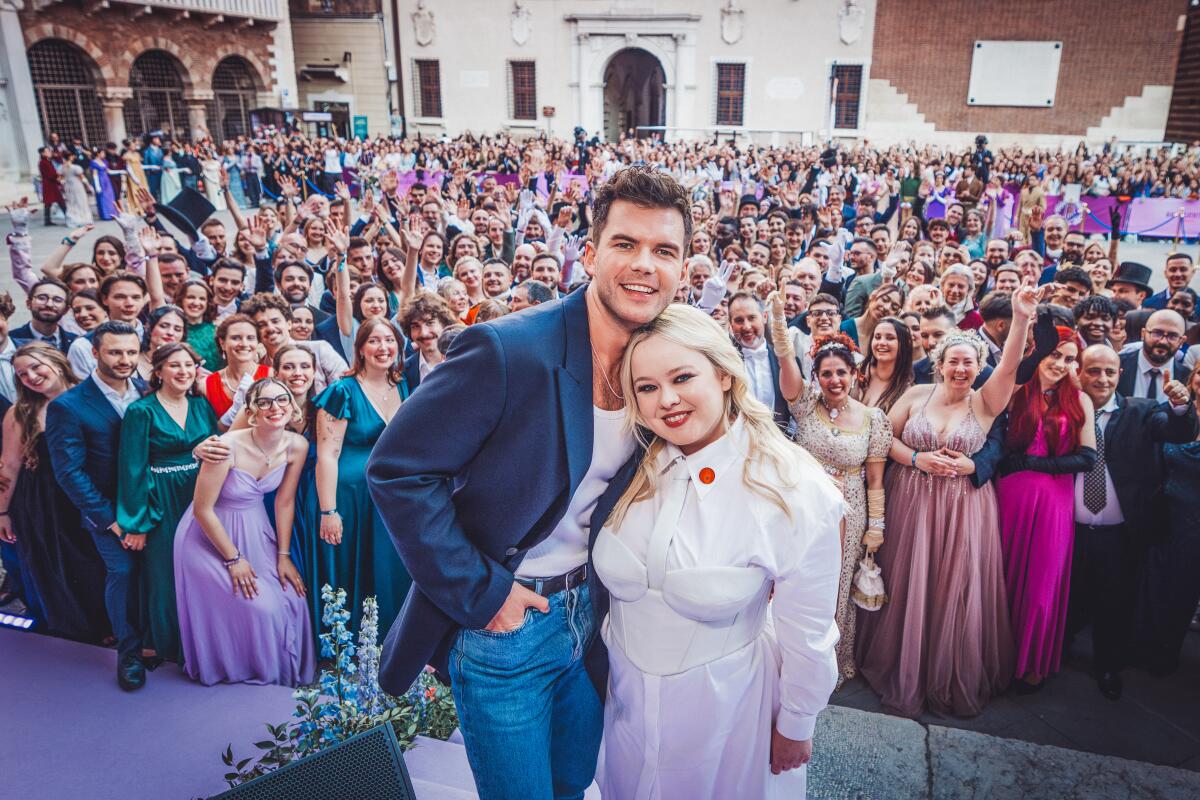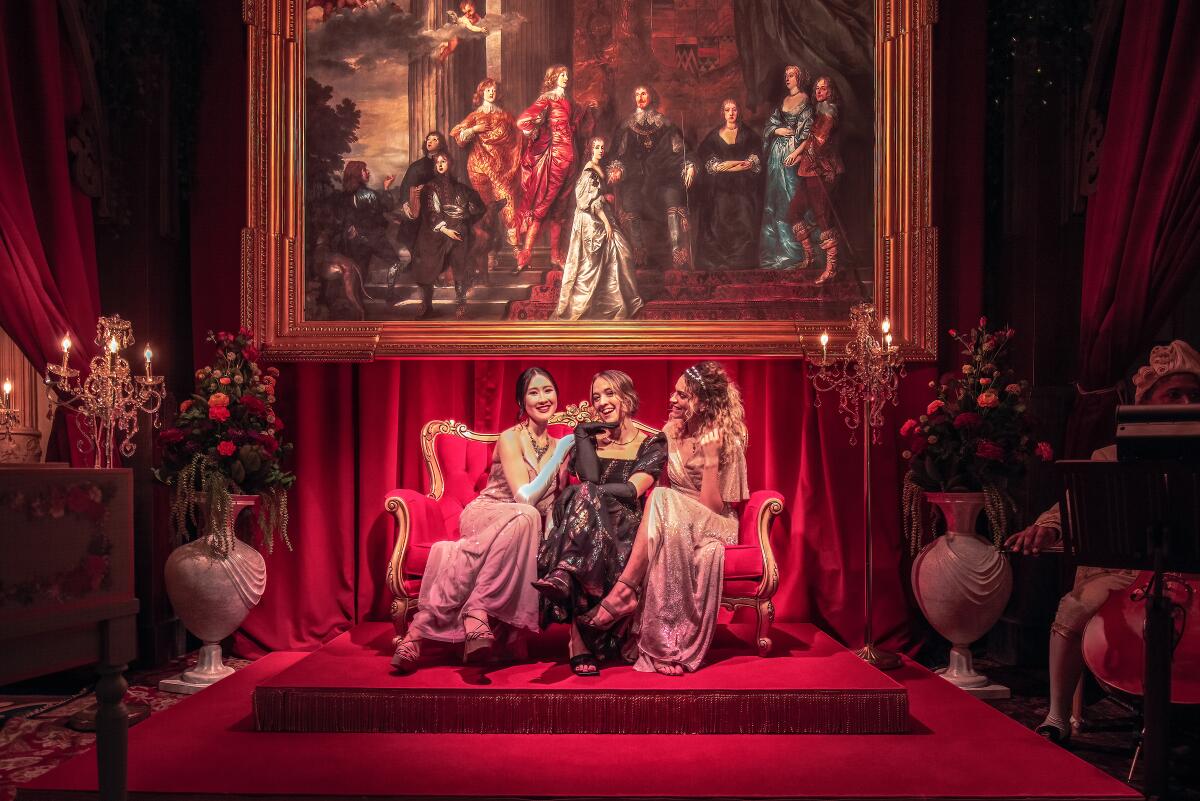Hollywood has become such a drag. Last year’s writers’ and actors’ strikes may be over, but the industry, along with the audience, is still paying the price. Everywhere you look there’s bad news: Box office is in the toilet. Television is in constriction mode. Studios and networks continue to merge, with mixed results. Writers, actors and crew members struggle to find work. Linear television is dying, and streaming subscribers are faced with rising prices and/or ill-placed and repetitive ads.
Then there’s “Bridgerton.” Tossing roses (Bridgerton-themed bouquets are now available at many florists) and trailing tea cakes (available at the Republic of Tea and Williams Sonoma), the third season of the Regency romance is shedding the light of a thousand (Bridgerton-inspired, Bath and Body Works-branded) candles on a weary and anxious business.
Forget “Deadpool and Wolverine,” “Despicable Me 4” or whatever film pundits are predicting will finally permeate the summer zeitgeist. If you have managed to avoid the ambitious and pervasive media campaign for “Bridgerton’s” now wildly popular third season, broken into two parts for maximum impact, you have better filters than I do.
Based on the novels of Julia Quinn, the first co-production of Netflix and Shonda Rhimes’ Shondaland debuted in the still COVID-plagued month of December 2020 and quickly became a pandemic hit. Reaching a broad and historically underserved audience of period-romance fans, “Bridgerton’s” audience grew with Season 2 and spinoff “Queen Charlotte.”
As the show gained momentum and the pandemic subsided, fan events began to appear — a Valentine’s Day-adjacent event was created in 2021 to celebrate love, and ”The Queen’s Ball: A Bridgerton Experience” debuted in Los Angeles in 2022 before touring the country. Behind-the-scenes content, interviews and some branded merchandise were made available on the Shondaland website and Netflix’s in-house publication TUDUM.
But none of it could have prepared one for “Bridgerton” Season 3, which didn’t so much premiere as invade. Globally.
Before the May release of the first four episodes, an advance campaign filled much of the world and its media with images of sexy carriages, sweeping gowns, twinkling gems, towering wigs and all the passion, suppressed and expressed, that a heaving décolletage could bear.

“Bridgerton” took over plazas, hotels and whole towns for fan events; created multinational influencer campaigns; and infiltrated every retailer from Ladurée to Target. It has filled the Billboard charts with its music and jammed everyone’s social feeds with clips, interviews, memes and general conversation about this season’s main couple, Penelope Featherington (Nicola Coughlan) and Colin Bridgerton (Luke Newton), fondly known as “Polin.”
That nickname was picked up by the CDC to remind people that allergies do not require antibiotics and by Flonase to offer a pharmaceutical alternative.
Even the U.S. government has been “Bridgerton”-ed — a recent posting for a job in the U.S. Embassy in London disguised itself as a missive from the series’ famed purveyor of gossip, Lady Whistledown.
And more is on its way as fans count down the days until the second half of the season drops on June 13.
You don’t have to be a superfan of Polin, Whistledown or “Bridgerton” itself to appreciate the glory of watching a franchise that knows its audience, and its worth, leverage both with the kind of publicity campaign historically reserved for Marvel, “Mission: Impossible” and peak “Game of Thrones.”
“Season 3,” said Netflix Chief Marketing Officer Marian Lee, “allowed us to go really big. Fans know the characters. We’ve been able to plan and go out with ‘This is the No. 1 show on Netflix.’ That made it easier.”
It’s also the first time, Lee adds, that the lack of COVID restrictions allowed the cast to roam freely. “This is the first time all this happened in real life, the first time we’ve taken [the cast] everywhere, so it feels new to them.”
New to the world as well. With its frothy romantic heart, macaron-hued palette and over-the-top ball scenes, “Bridgerton” is the antithesis of the kind of who-will-rule-the-world Comic-Con darlings that typically get event- and experience-driven campaigns. Yes, there was an actual duel in Season 1, but any violence in “Bridgerton” is of the emotional variety — the series deals almost exclusively with the battlefield of love. And family. And finery.
“It’s a fresh take on things,” said Lee. “It’s joy, palace intrigue, love and family and friendship. Not quite wholesome,” she added, with a laugh, in reference to the show’s notoriously steamy sex scenes, “but a nice story in which the world is not about to end.”
For those who do not follow the show, or who have somehow managed to avoid the deluge of publicity it has generated, “Bridgerton” revolves around the romantic lives of the Bridgerton family and other members of the Ton, a group of 18th century British elite gathered around the court of Queen Charlotte (Golda Rosheuvel). Narrated by the popular if feared purveyor of local gossip, Lady Whistledown (voiced by Julie Andrews), each season focuses on the courtship and eventual marriage of one Bridgerton child.
In Season 3, that would be Colin, the family’s third son, who finally comes to terms with his feelings for Penelope, a longtime friend who has yearned for him for years. For a variety of reasons (not the least of which is Coughlan herself), Penelope is a fan favorite and “Polin’s” friends-to-lovers storyline has been much anticipated.

To intensify that anticipation, Netflix leaned on its international presence and sent Coughlan, Newton and other cast members on a 10-country press tour.
An Australian town was transformed into the Ton. A ball in Verona, Italy, allowed 50 couples to become engaged or renew their wedding vows. A “Bridgerton” themed garden bloomed at the Chelsea Flower Show, a “Bridgerton” promenade filled New York’s Meatpacking District and “The Queen’s Ball: A Bridgerton Experience” went global, debuting in Melbourne this month.
As it turns out, Regency romance fans love to cosplay as much as any Marvel or “Game of Thrones” buff. “I am always surprised at how many people will stand in line for hours in these amazing costumes,” Lee said.
Meanwhile, a steady rain of video content soaked every media platform available: trailers, clips and photos, obviously, plus a welter of behind-the-scenes clips — always fun to see wig maintenance and actors trying to stay warm in period costumes — and every sort of interview imaginable with the large and winning cast.
As someone who likes the show but is in no way a superfan, I was shocked at the amount of content it has dropped into my social feeds. At first it was vaguely annoying, but cast members such as Rosheuvel, Coughlan and Claudia Jessie, who plays Eloise Bridgerton, were so game and charming I got sucked right in.
I have watched hours of these actors being quizzed on Regency terms and quotes from the show, trying to identify their male castmates from photos of their sideburns and women from their jewelry, giving readings of famous “Bridgerton” lines in American accents and ordinary instructions in “a sexy voice,” being interviewed with puppies, with tea cups and about the difficulties of using the toilet while in costume.
Then there’s the merchandise — not just the stuffed corgis or Penelope T-shirts but also Maxbone pet accessories, Allure Bridal dresses, Risque nail polish and Izzy and Liv’s newly launched Bridgerton line.
And that, gentle reader, is not all; The crowning moment of this year’s campaign is an actual “Bridgerton” wedding. Series superfans and real-life friends-to-lovers Shanti Hinton and Tiffany Rae were treated to a Ton fantasy wedding, documented in chapters on Netflix’s YouTube channel and TUDUM.
Hinton and Rae make a glorious (and amazingly camera-ready) couple, but for the entertainment industry, it’s not just their love that lifts up the moment. It’s the optimism. Hollywood, it turns out, can still make dreams come true.
I know, I know, it’s marketing, made possible by the unique partnership of heavy hitters Netflix and Shondaland. Netflix may have the algorithms (and apparently some money), but Rhimes has been on the forefront of audience engagement since she blogged about “Grey’s Anatomy” on the ABC website.
Not that the money doesn’t matter. It is obviously quite expensive to sell a show in this way. In the wake of the strikes and in the midst of so many layoffs, including at Netflix, “Bridgerton’s” media blitz could be perceived as a bit out of tune in a “Let them eat cake” kind of way.
But at a time of so much uncertainty, when Hollywood seems to have forgotten how to do the things it does best, it is also exhilarating to see a flex this big.
Particularly for a series aimed toward women, without a sword, crossbow or lightsaber in sight. Fan events, activations and immersive experiences are not new to television marketing, but sci-fi and fantasy, with their alternative worlds, life-or-death stakes and big bad villains, have traditionally claimed the biggest share of marketing budgets. “Game of Thrones” put a fake dragon’s skull on the beach of Dorset’s Jurassic Coast, for heaven’s sake.
“Bridgerton,” on the other hand, leans into a more sedate, swishing-skirt fantasy last served by “Downton Abbey,” which provided something of a beginner’s manual, with its high teas and themed events. (In fact, ”Downton Abbey: The Exhibition” is still on tour.)
But Netflix is not PBS, Rhimes is not Julian Fellowes and “Bridgerton” is not “Downton Abbey.” It’s a youthful, unapologetic bodice-ripping romance, with a diverse cast and cosplay-ready fans who are eager to meet and greet and finally have their numbers counted.
“Deadpool and Wolverine” had better tighten their corsets, because this summer it’s going to be tough to out-splash “Bridgerton.”
